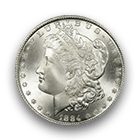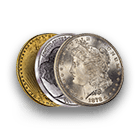Have you ever wondered how common a “common” coin is? It’s not a question that always comes with a stock answer. That’s because in numismatics, “common” is often a relative term. When many folks speak of “common” coins, they may be referring to coins whose mintages (and often current population estimates) are in, say, the millions or even billions.
Yet, even when reading about rare coins, or at least those coins that are widely regarded as “rare,” you’re bound to see references to said pieces being considered “common” in the context of rarity. This is often the case with popular rarities such as the 1909-S VDB Lincoln Cent or 1916-D Mercury Dime, which are two popular key dates that are indeed held as “rarities” in the minds of many yet are common enough that you might find several – even many examples – at a major coin show.
It can seem confusing when you may hear or read various numismatic experts talking about the same coins as both rare and common. But there’s a set of clear-cut guidelines for determining if a coin is common or rare in the absolute sense: the PCGS CoinFacts Rarity Scale.
The PCGS CoinFacts Rarity Scale reveals that a coin with 100,001 or more surviving specimens is categorically “common.” Such a coin has a rarity rating of 1.9 or lower (down to 1.0). Conversely, coins with fewer than 100,001 specimens can be considered “scarce” or “rare,” depending on where along the PCGS CoinFacts Rarity Scale given pieces fall.
Going back to our earlier examples of the 1909-S VDB Lincoln Cent and 1916-D Mercury Dime, we find that the former overall ranks 2.5 (50,000 survivors and “scarce”) and the latter has a general ranking of 3.0 (10,000 survivors, thus “very scarce”). Bear in mind that both coins are significantly rarer in higher grades.
If you want to learn more about how common (or rare) a coin is, you should check out the PCGS CoinFacts Rarity Scale for yourself. It’s an immensely helpful tool for determining what’s rare and what’s not!







 Copper & Nickel
Copper & Nickel
 Silver Coins
Silver Coins
 Gold Coins
Gold Coins
 Commemoratives
Commemoratives
 Others
Others
 Bullion
Bullion
 World
World
 Coin Market
Coin Market
 Auctions
Auctions
 Coin Collecting
Coin Collecting
 PCGS News
PCGS News